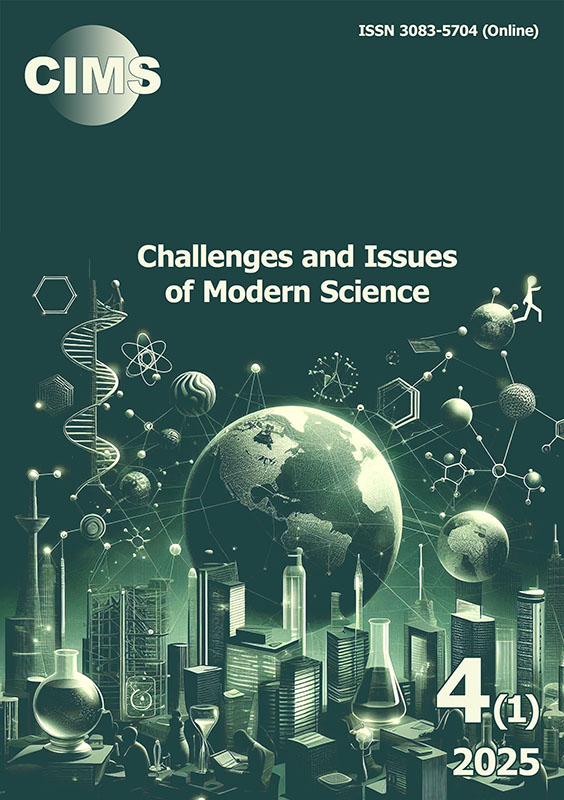The Impact of Emotionally Driven Service on Customer Loyalty in the Beauty Services Sector
DOI:
https://doi.org/10.15421/cims.4.274Keywords:
emotional service, customer loyalty, beauty industry, personalized service, non-verbal communication, client experienceAbstract
Purpose. This article aims to theoretically substantiate and empirically investigate the impact of emotional service on customer loyalty in the beauty industry. It identifies key emotional interaction factors that enhance customer satisfaction and the competitive advantage of beauty service providers. Design / Method / Approach. The study employs an empirical approach based on a survey conducted at the “Women Place” beauty salon in Odesa, Ukraine. Forty regular clients participated, evaluating the significance of emotional and personalized service components. Data was analyzed using descriptive statistics and visualized through percentage-based charts. Findings. The research reveals that personalized communication, staff politeness, cleanliness, interior design, music, and aromatherapy influence customer loyalty. Emotional service plays a critical role in shaping positive client experiences and strengthening brand affiliation. Clients value not only service quality but also the emotional atmosphere and individual approach. Theoretical Implications. This study contributes to understanding emotional service as a strategic tool for loyalty development in the Ukrainian beauty industry. It broadens the theoretical framework by integrating emotional labor, non-verbal communication, and personalization into customer behavior analysis. Practical Implications. The findings offer practical recommendations for beauty business managers to improve emotional interaction processes, implement CRM systems, and develop customer-oriented strategies to retain clientele and reduce churn. Originality / Value. This is one of the first comprehensive empirical studies in Ukraine examining emotional service in loyalty formation, considering sensory, behavioral, and personalized dimensions. Research Limitations / Future Research. The study is limited to one beauty salon. Future research may compare other market segments and explore demographic factors influencing emotional service perception. Article Type. Applied Research.
Downloads
References
Al-Adilee, S. M. S. (2024). The effect of colors and harmony in the design of interior spaces and a case study of the effect of colors. European International Journal of Multidisciplinary Research and Management Studies, 4(12), 157-164. https://inlibrary.uz/index.php/eijmrms/article/view/61323
Banyte, J., Gadeikiene, A., Rutelione, A., & Kakneviciene, I. (2016). Expression of Personalization while Developing Long-Term Relationships with Service Customers. Engineering Economics, 27(4). https://doi.org/10.5755/j01.ee.27.4.14159
Berezivska, O. (2025). Serviceology for hotel and restaurant business enterprises: Opportunities and challenges. Current Issues of Economic Sciences, (7). https://doi.org/10.5281/zenodo.14896587
Borysiuk, I., Yaremkevych, R., Sviatenko, T., Striukov, V., & Krupskуi, O. (2022). El impacto de la pandemia de COVID-19 en la educación de los estudiantes de medicina. Apuntes Universitarios, 13(1), 164–189. https://doi.org/10.17162/au.v13i1.1322
Chun, S.-K., & Park, E.-J. (2023). The Effect of Hair Salon Visiting Standards on Customer Satisfaction and Revisit of Middle-Aged People. Journal of the Korean Society of Cosmetology, 29(5), 1277–1285. https://doi.org/10.52660/jksc.2023.29.5.1277
Chun, S.-K., Lee, J.-H., Yoo, H.-M., & Park, E.-J. (2023). The Effect of Nonverbal Communication of Hair Designer on Customer Satisfaction and Revisit: For Middle-aged People aged 40 to 64 years of age. Journal of the Korean Society of Cosmetology, 29(3), 593–604. https://doi.org/10.52660/jksc.2023.29.3.593
Coelho, P. S., & Henseler, J. (2012). Creating customer loyalty through service customization. European Journal of Marketing, 46(3/4), 331–356. https://doi.org/10.1108/03090561211202503
Cunha, M., & Krupskyi, O. (2023). When the Sensory World is Set Aside! The New Fantastic World of Luxury. Economics: Time Realities, 6(70), 44–53. https://doi.org/10.15276/etr.06.2023.6
Dhillon, R., Agarwal, B., & Rajput, N. (2021). Determining the impact of experiential marketing on consumer satisfaction: A case of India’s luxury cosmetic industry. Innovative Marketing, 17(4), 62–74. https://doi.org/10.21511/im.17(4).2021.06
Dovzhanyn, Y. (2021). Criminal liability for health damage as a result of poor-quality cosmetological services. International Scientific Journal “Internauka,” 11(166). https://doi.org/10.25313/2520-2057-2024-11-10454
Falkiewicz, S., Wohlgemuth, V., & Bogodistov, Y. (2016). Entrepreneurship: society and resource management. A review of current scientific trends. European Journal of Management Issues, 24(6), 3-14. https://doi.org/10.15421/191601
Fink, L. K., Warrenburg, L. A., Howlin, C., Randall, W. M., Hansen, N. Chr., & Wald-Fuhrmann, M. (2021). Viral tunes: changes in musical behaviours and interest in coronamusic predict socio-emotional coping during COVID-19 lockdown. Humanities and Social Sciences Communications, 8(1). https://doi.org/10.1057/s41599-021-00858-y
Gajanova, L., Nadanyiova, M., & Moravcikova, D. (2019). The Use of Demographic and Psychographic Segmentation to Creating Marketing Strategy of Brand Loyalty. Scientific Annals of Economics and Business, 66(1), 65–84. https://saeb.feaa.uaic.ro/index.php/saeb/article/view/1115
Grandey, A. A. (2000). Emotional regulation in the workplace: A new way to conceptualize emotional labor. Journal of Occupational Health Psychology, 5(1), 95–110. https://doi.org/10.1037/1076-8998.5.1.95
Grandey, A. A. (2003). When “the show must go on”: Surface acting and deep acting as determinants of emotional exhaustion and peer-rated service delivery. Academy of Management Journal, 46(1), 86-96. https://www.jstor.org/stable/30040678
Hashem, T. N., Nimer Ali, D. N., & Allan, D. M. (2020). Influence of emotional marketing on brand loyalty among females in the field of cosmetics: Mediating role of customer satisfaction. International Journal of Management, 11(9), 1245-1260. https://tinyurl.com/5evssr9h
Heo, S., & Kim, S. (2016). Influence of Emotional Experience at the Beauty Salon on Store Preference. Fashion Business, 20(6), 19–31. https://doi.org/10.12940/jfb.2016.20.6.19
Herlina, M. G., & Dewi, J. J. A. (2022). The Impact of Service Quality and Price on Customer Satisfaction in Building Customer Loyalty. In Proceedings of the 7th North American International Conference on Industrial Engineering and Operations Management, Orlando, Florida, USA (pp. 601-611).. https://doi.org/10.46254/na07.20220166
Jagannathan, K., Rupashree, R., SakthiPriya, E., Chandrakhanthan, J., Devaram, N., & Sudhakar, K. (2024). “Gen-Z”-Virtual Pick up Behavior “The Evolving Landscape of the Organic Beauty and Personal Care.” Anticipating Future Business Trends: Navigating Artificial Intelligence Innovations, 117–128. https://doi.org/10.1007/978-3-031-63569-4_11
Jeon, H., & Park, J. (2021). The Effect of the Beauty Service Quality for HUMANS on the Customer Satisfaction and the Customer Loyalty. J-Institute, 6(3), 22–34. https://doi.org/10.22471/disaster.2021.6.3.22
Jin, N., Line, N. D., & Goh, B. (2013). Experiential value, relationship quality, and customer loyalty in full-service restaurants: The moderating role of gender. Journal of Hospitality Marketing & Management, 22(7), 679-700. https://doi.org/10.1080/19368623.2013.723799
Kafaei, M., Latifi, M., Burry, J., Ciorciari, J., Aminitabar, A., & Ji, K. (2025). Sensory design with scent: Exploring the impact of ambient smell on emotions and physiological responses in the office environment. Building and Environment, 271, 112626. https://doi.org/10.1016/j.buildenv.2025.112626
Khan, P., & Tabassum, A. (2010). Service quality and customer satisfaction of the beauty-care service industry in Dhaka: a study on high-end women’s parlors. Journal of Business in Developing Nations, 12(33). https://ssrn.com/abstract=2180745
Khytra, O. (2021). Peculiarities of impression management application in tourism business. Tourism and Hospitality Industry in Central and Eastern Europe, (3), 49-60. https://doi.org/10.36477/tourismhospcee-3-8
Kim, D., Hyun, H., & Park, J. (2020). The effect of interior color on customers’ aesthetic perception, emotion, and behavior in the luxury service. Journal of Retailing and Consumer Services, 57, 102252. https://doi.org/10.1016/j.jretconser.2020.102252
Kim, D.-E., & Park, E.-J. (2023). The Effect of Beauty Salon Selection Attributes on Customer Emotional Response and Behavioral Intention. Journal of Health and Beauty, 17(1), 98–109. https://doi.org/10.35131/ishb.2023.17.1.98
Ko, E., & Megehee, C. M. (2012). Fashion marketing of luxury brands: Recent research issues and contributions. Journal of Business Research, 65(10), 1395–1398. https://doi.org/10.1016/j.jbusres.2011.10.004
Kolodkina, Y., & Krupskyi, O. (2024). Analysis of the conditions for starting a small business in the beauty industry: the case of the city of Dnipro. Challenges and Issues of Modern Science, 3, 265–273. https://cims.fti.dp.ua/j/article/view/217
Krupskyi, O., Stasiuk, Y., & Huk, O. (2024). Improving business efficiency in cosmetology institutions. Innovative Economy, (3), 92-102. https://doi.org/10.37332/2309-1533.2024.3.12
Lee, Y. M., & Rhee, N. H. (2008). A Study on the impact of service quality on service loyalty in the beauty service: The mediating roles of relationship quality and switching cost. Fashion & Textile Research Journal, 10(5), 625-635. https://koreascience.kr/article/JAKO201608450941291.page
Lysytsia, N., Martynenko, M., Byelikova, Y., & Polyakova, Y. (2021). Service Innovations Management Based On Emotional Intelligence in Ukraine. Studies of Applied Economics, 38(4). https://doi.org/10.25115/eea.v38i4.3992
Makhlouf, S. (2014). An integrated model of service quality and customer loyalty: Investigating the mediating effects of customer value and customer satisfaction [Master's thesis, Middle East University]. Middle East University Repository. https://meu.edu.jo/libraryTheses/58749f3e3004a_1.pdf
Mangarin, R. A., & Gonzaga, J. C. (2021). Service Quality and Customer Satisfaction among Beauty Salons. International Journal of Research and Innovation in Social Science, 5(5), 67–72. https://dx.doi.org/10.47772/IJRISS.2021.5503
Mittal, B., & Lassar, W. M. (1996). The role of personalization in service encounters. Journal of Retailing, 72(1), 95–109. https://doi.org/10.1016/s0022-4359(96)90007-x
Morin, S., Dubé, L., & Chebat, J.-C. (2007). The role of pleasant music in services capes: A test of the dual model of environmental perception. Journal of Retailing, 83(1), 115–130. https://doi.org/10.1016/j.jretai.2006.10.006
Muhammed Rafi, K. K., & Edakkotte, S. (2024). Influence of Emotional Marketing and Brand Loyalty of Cosmetics Products. International Journal for Multidisciplinary Research, 6(3). https://doi.org/10.36948/ijfmr.2024.v06i03.22523
Obiegbu, C. J., & Larsen, G. (2024). Algorithmic personalization and brand loyalty: An experiential perspective. Marketing Theory. https://doi.org/10.1177/14705931241230041
Okeke, N. I., Alabi, O. A., Igwe, A. N., Ofodile, O. C., & Ewim, C. P. M. (2024). Customer journey mapping framework for SMES: Enhancing customer satisfaction and business growth. World Journal of Advanced Research and Reviews, 24(1), 2004–2018. https://doi.org/10.30574/wjarr.2024.24.1.3206
Olamilekan, O. A., & Dastane, O. (2014). Employee Emotional Competency in Establishing Consumer Satisfaction and Loyalty: Mediate Role of Rapport in Malaysia Spa and Beauty Industry. SSRN Electronic Journal. https://doi.org/10.2139/ssrn.2639670
Park, E.-Y. (2023). The Effect of Relationship Benefits on Relationship Commitment and Customer Loyalty in the Beauty Service Industry. Asian Journal of Beauty and Cosmetology, 21(2), 323–334. https://doi.org/10.20402/ajbc.2023.0053
Park, J.-H., & Park, E.-J. (2022). The Effect of the Appearance of Beauty Workers on the Emotional Response and Behavioral Intention of Customers. Journal of the Korean Society of Cosmetology, 28(6), 1201–1209. https://doi.org/10.22156/CS4SMB.2022.12.01.127
Park, Y. W., & Hong, P. (2024). Beauty Reimagined: Navigating the Cosmetic Industry’s Digital Transformation. Cosmetics Marketing Strategy in the Era of the Digital Ecosystem, 47–74. https://doi.org/10.1007/978-981-97-3674-4_3
Parkhomenko, N. & Denysiuk, O. (2023). Trends in the Development of the World and Ukrainian Markets of Cosmetic Products. Modern Economics, 38(1), 125–131. https://doi.org/10.31521/modecon.v38(2023)-19
Sahota, A. (Ed.). (2014). Sustainability: how the Cosmetics Industry is Greening UP. John Wiley & Sons. https://tinyurl.com/esbx9c34
Sari, E. K., & Wijaya, S. (2019). The Role of Emotional Brand Attachment and Customer Trust in Enhancing Customer Experience s Effect on Customer Loyalty Towards Beauty Clinics in Surabaya. Petra International Journal of Business Studies, 2(1), 18-26. https://core.ac.uk/download/pdf/227194272.pdf
Sirirat, S., Pongsermpol, C., & Moorapun, C. (2025). Scent as a Strategic Element of Hotel Design to enhance Guest Experience. Journal of Ecohumanism, 3(8). https://doi.org/10.62754/joe.v3i8.5704
Stasiuk, Y. M. (2009). Formation of the economic culture of a young specialist. Personality in the Space of Culture: Proceedings of the All-Ukrainian Scientific and Practical Symposium, 24, 100–102. https://tinyurl.com/3sufy975
Sviderska, S., Zhylinska, O., & Kukhta, P. (2023). Identification of the Factors Influencing the Cosmetic Products Market (Ukraine Case). Studies in Business and Economics, 18(1), 328–341. https://doi.org/10.2478/sbe-2023-0018
Tambayong, M. M., & Tan, P. H. P. (2022). The impact of service quality attributes of beauty parlors towards customer loyalty through customer satisfaction and trust. JPPI (Jurnal Penelitian Pendidikan Indonesia), 8(3), 817. https://doi.org/10.29210/020221574
Vorobiova, V. V., Krupskyi, O. P., & Stasiuk, Y. (2023). The Role of Digital Technologies in Modern Trade: A Study of Global Trends and Prospects for Ukraine. Economic journal Odessa polytechnic university, 2(24), 44–55. https://doi.org/10.15276/EJ.02.2023.5
Wu, I., & Liang, C. (2025). Embracing New Love: Why Customers Are Loyal to Plant Extract‐Based Skin‐Care Cosmetics. Journal of Cosmetic Dermatology, 24(1). Portico. https://doi.org/10.1111/jocd.16731
Yupelmi, M., Yulastri, A., Effendi, H., & Muskhir, M. (2023). A Comprehensive Exploration of Entrepreneurial Strategies in the Makeup and Beauty Industry: The Role of Social Media Marketing. The Indonesian Journal of Computer Science, 12(5). http://ijcs.net/ijcs/index.php/ijcs/article/view/3439
Zharova, L. (2021). Service Sector After-Pandemic Recovery-focus on Ukrainian beauty sector. Scientific Journal of Bielsko-Biala School of Finance and Law, 25(2), 24-29. https://asej.eu/index.php/asej/article/view/576
Downloads
Published
Versions
- 2025-06-24 (2)
- 2025-04-15 (1)
Issue
Section
Categories
License
Copyright (c) 2025 Yelyzaveta Kravchuk , Oleksandr Krupskyi (Author)

This work is licensed under a Creative Commons Attribution 4.0 International License.
All articles published in the journal Challenges and Issues of Modern Science are licensed under the Creative Commons Attribution 4.0 International (CC BY) license. This means that you are free to:
- Share, copy, and redistribute the article in any medium or format
- Adapt, remix, transform, and build upon the article
as long as you provide appropriate credit to the original work, include the authors' names, article title, journal name, and indicate that the work is licensed under CC BY. Any use of the material should not imply endorsement by the authors or the journal.



















